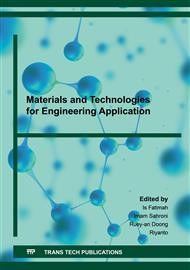[1]
V. Ageng, R. Lukman, The Study of Improving Salt Using Washing Method, J. Tech. Lear. Imp. 2 (2020) 23-30.
Google Scholar
[2]
M. Nilawati, Purification and Iodization Solid Waste Blotong to Food Salt, Biopropal Industry. 6 (2015) 43-48.
Google Scholar
[3]
D. Lesdantina, Istikomah, Purification of NaCl Using Sodium Carbonate, University of Diponegoro, Indonesia, (2016).
Google Scholar
[4]
Sulistyaningsih, Purification of Kitchen Salt Through the Old Water Crystallization Method with Na2C2O4-NaHCO3 and Na2C4O4-Na2CO3. University of Diponegoro, Indonesia, (2011).
Google Scholar
[5]
A.L. Rositawati, C. Metasari, D. Soetrisnanto, Recrystallization of Crude Salt to Industry Salt, J. Chem. Ind. Tech. 2 (2013) 1-7.
Google Scholar
[6]
A.F. Zandhika, Innovation of Salt with Added Poly Aluminum Chloride to Produce Standardized Salt Industry. Institut Teknologi Sepuluh Nopember, Indonesia, (2016).
Google Scholar
[7]
W. Dyah, P.A. Handayani, Treatment of Crude Salt to Aromateraphy Salt, J. Tech. Lear. Imp. 2 (2012) 30-35.
Google Scholar
[8]
R.U. Rahman, A. Islam, M.A. Farrukh, Preparation of Analytical Grade Sodium Chloride from Khewra Rock Salt, World Appl. Sci. J. 9 (2010) 1223-1229.
Google Scholar
[9]
R. Boopathy, G. Sekaran, Studies on Process Development for the Separation of Sodium Chloride from Residue After Evaporation of Reverse Osmosis Reject Solution, Sep. Purif. Technol. 183 (2013) 127-132.
DOI: 10.1016/j.seppur.2017.04.008
Google Scholar
[10]
A. Heshmati, A. Vahidinia, I. Salehi, A. Avicenna, Determination of Heavy Metal Levels in Edible Salt, J. Med. Biochem. 2 (2014) 19836-19841.
DOI: 10.17795/ajmb-19836
Google Scholar
[11]
P.D. Johnson, P. Girinathannair, K.N. Ohlinger, S. Ritchie, L. Teuber, J. Kirby, Enhanced Removal of Heavy Metals in Primary Treatment Using Coagulation and Flocculation, Water Environ. Res. 80 (2008) 472-477.
DOI: 10.2175/106143007x221490
Google Scholar
[12]
P. Gebbie, A Dummy's Guide to Coagulants (68th Annual Water Industry Engineers and Operators, Conference Schweppes Centre, Bendigo, (2005).
Google Scholar
[13]
F.M. Pang, P. Kumar, T.T. Teng, O.K.M. Omar, K.L. Wasewar, Removal of Lead, Zink, and Iron by Coagulation-flocculation, J. Taiwan. Inst. Chem. E. 42 (2011) 809-814.
DOI: 10.1016/j.jtice.2011.01.009
Google Scholar


